 |
Please note : There are lots of large
pictures on this page which may take some time to download.
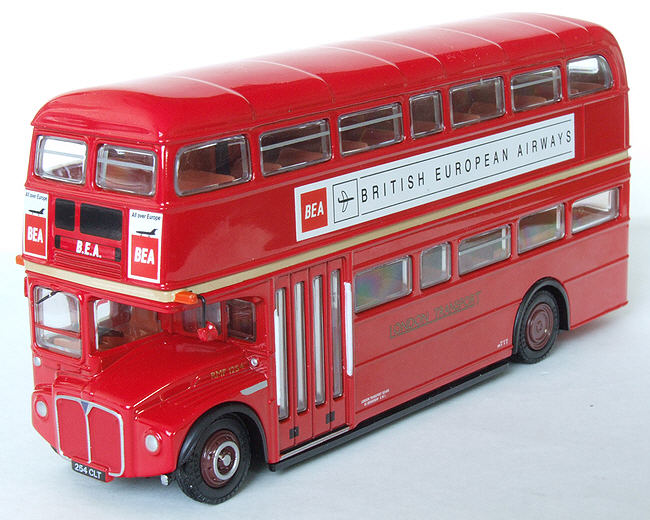
32101 RMF1254 the Long Front Entrance Routemaster
|
A Brief History
RMF1254
RMF1254 made it's debut at the 1962 Earl's Court Commercial Motor Show where it was exhibited on the Park Royal stand. The vehicle was built to try a stimulate sales of the Routemaster to other operators who were looking for high capacity vehicles which in the fullness of time would prove suitable for driver only operation.
The modular design of the Routemaster allowed a very high proportion of standard parts to be used on the RMF, the bus was built to the new longer RML length it could seat 69 passengers. The staircase was repositioned behind the drivers cab and a four leaf folding platform door was fitted. The front near side bulkhead window was modified to allow the driver to turn around in his cab and deal with passengers through an angled opening over the engine compartment. The rear design incorporated a single large lower deck window and an emergency exit door that fitted in the rear most off-side bay.
London Transport took delivery of RMF1254 on the 19th October 1962, and a week later the bus was dispatched to Liverpool Corporation where it entered service on route 27 on the 29th October.
The vehicle returned from Liverpool on the 26th November and although it was expected a trail on a London route would take place this never actually happened. In March 1963 it was dispatched to East Kent for a month long trial alongside an AEC Renown. Neither of the operators were persuaded by their use of the RMF and London Transport plans to cover some of the Routemaster's development cost by making it available on the open market looked doomed.
RMF1254 disappeared from public view for over a year, and during this time the original front headlamp panels with the brake cooling grilles were replaced with a new experimental design, this was deeper and totally removed any evidence of the former grilles. Also during this period the large air intake below the front destination was reduced in height by half allowing the cream band to extended unbroken across the front, this latter modification was adopted as the standard for all new Routemaster in 1964. The revised headlamp panels design eventually adopted for the RCL's and the main batch of RML's.
During 1962 the Ministry of Transport relaxed rules preventing buses from towing trailers, this change was of particular interest to BEA on whose behalf London Transport ran a coach service between Heathrow Airport and the West London Air Terminal.
At the end of 1963 RM8 was experimentally fitted with a towing hook and used to test the feasibility trailer use. Shortly after this trial a decision was taken to modify RMF1254, internally the rear lower deck bench seat was removed to allow increased space for hand luggage, externally the London Transport fleet names and red livery were retained although a towing hook and electrical connections were added along with some suitable BEA advertising.
The bus took up it duties on the BEA route on the 1st June 1964 and continued to work the service for two years and 2 months, during this period it went on fortnight's trial to Halifax Corporation, but again no orders were generated.
It's use on the BEA service proved successful and eventually resulted in BEA ordering a fleet 65 front entrance Routemasters which were later classified RMA by London Transport. RMF1254 was de-licenced on 24th October 1966 shortly before the first of the new BEA vehicles were delivered, it was sold to Northern General a month later where it spent almost 14 years in service alongside Northern's own Routemasters.
|
|
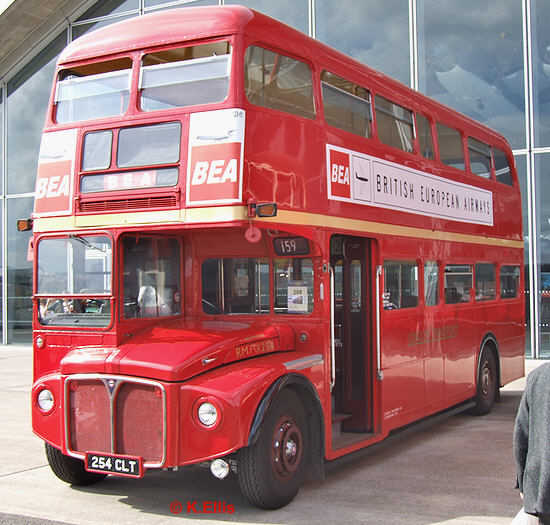 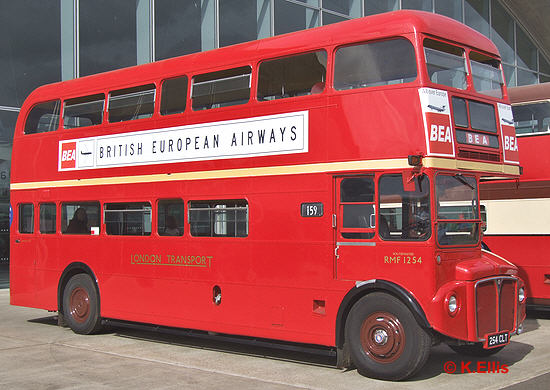
The preserved RMF1254 as it appeared at the 2006 EFE Showbus International Rally
|
A Brief History
Northern General Routemasters
Following RMF1254's appearance at the Commercial Motor Show in 1962 it quickly became apparent that most operators viewed the Routemaster as too expensive or over complicated, the Leyland Atlantean and Daimler Fleetline were gaining support and offered a better option for any future driver only operations. Despite several trials no orders materialised until 1963 when to the surprise of many Northern General announced order for 50 front entrance Routemasters
The first batch of 18 buses, 2085-2102 (RCN685-702) began to arrive in March 1964, these were clearly based on the prototype vehicle but featured a number of modifications to meet Northern's own requirements.
Seating capacity was increased to 72 and a standard Northern two piece destination display was fitted at the front. The small front under canopy route number box was omitted while the standard London quarter drop window ventilators were replaced by sliding units, a single sealed unit also replaced the two piece opening divers windscreen.
Theses buses were delivered with the deep air intakes below the front destination and had brake cooling grilles in the front headlamp panels. Under the skin there were also several mechanical changes including the fitting of a Leyland engine in place of the standard AEC unit.
The first vehicles entered service on the 1st May from the Bensham and Chester-Le_Street depots.
The second and final batch of 32, 2103-2134 (BUP249B, EUP404-407B, FPT578-604C) were delivered between October 1964 and June 1965, these buses had a few superficial changes on the outside that reflected the developments made to the London vehicles. The front air intake grille was reduced in size, allowing the cantrail to continue unbroken across the front. The intake grilles for the brakes were also panelled over on the front headlamp panels.
The new deliveries resulted in two further depots, Consett and Sunderland gaining allocations of the type.
The prototype RMF1254 was purchased by Northern General on the 25th November 1966 and before entering service had it's AEC engine replaced with a Leyland unit. The London style destinations were removed and a standard Northern display added to the front. After repainting into Northern livery it took fleet number 2145 but remained easily distinguishable from Northern's other vehicles due to it's London style quarter drop windows, opening drivers windscreen and unique style of front headlamp panels.
The Northern Routemasters eventually gained the National Bus Company Poppy Red livery and were renumbered in January 1975 with the main batch becoming 3069-3118 and former RMF 1254 taking 3129. The buses soldiered on until May 1977 when the first examples were withdrawn, gradually the rest of the buses were taken out of service over the next two and a half years with the very last 3105 retiring on the 16th December 1980.
Very few of the Northern Routemasters escaped the breakers torch, 12 were purchased by London Transport with a view to further service but in the event the project wasn't deemed viable and the buses were all disposed of without ever being used.
Several examples did get to operate in the capital however, four example owned by the Obsolete fleet or Brakell of Cheam were hired to London Transport who used them on their Central London Sightseeing Tour for several years, another example was later purchased by London Coaches and again employed on the capitals sightseeing service.
Several examples were purchased by the Big Bus Company for use on their own London sightseeing tours while another bus was used by Stevenson's of Uttoxeter and then Stagecoach Magicbus.
|
|
The Model
The final new Routemaster casting is clearly based very closely on the actual prototype vehicle RMF1254, there's no doubt that the model is a pretty accurate rendition of this vehicle and comparing it with the photograph's of the now preserved RMF1254 (see above) would suggest EFE have done a pretty good job.
|
|
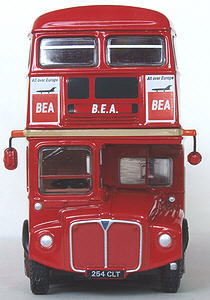
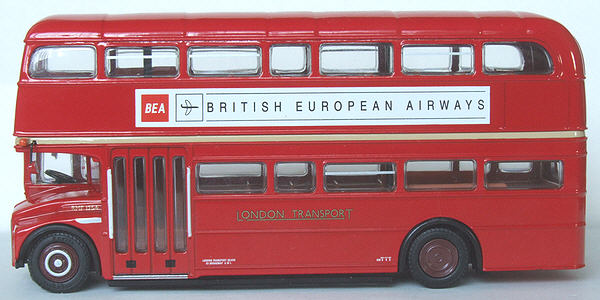
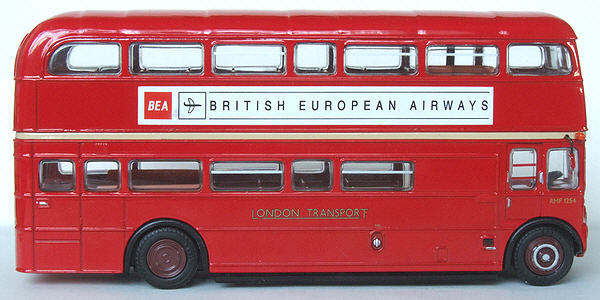
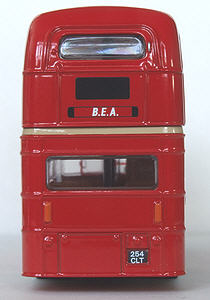
|
|
Like the RMA model the correct four leaf doors are modeled and once again the modified front bulkhead window is reproduced using a clear plastic insert.
|
|
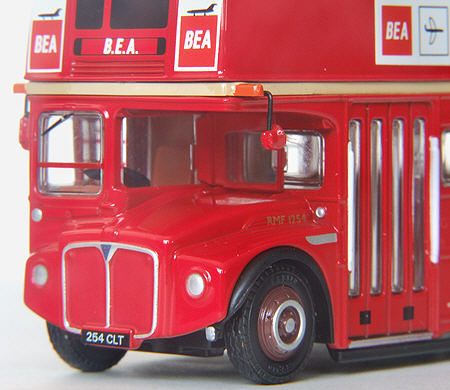
|
|
The frontal treatment of the model although accurate for RMF1254 does raise a few issues concerning any future releases. EFE have modeled the revised front headlamp panels without the brake cooling grilles, the problem is that this arrangement was unique to RMF1254, all the Northern examples were fitted with the earlier style of panels as found on the re-tooled standard RM model, furthermore it appears these panels remained in place during their entire life with the company. Whether EFE can alter these on future releases isn't known, different headlamp panels were certainly available for the original RCL casting as one model was produced with single instead on twin headlamps.
Likewise the under canopy route box has been cast, unfortunately this feature was only originally found on RMF1254.
|
|
|
The rear of model is very similar to the RMA although in this case the towing hook has been omitted even though RMF1254 is known to have been equipped to tow a trailer while allocated to the BEA service.
|
|
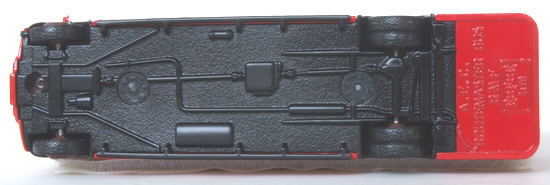
|
|
The base reveals a three quarter length plastic base plate on to which have been moulded some of the basic chassis details The rear most quarter is cast in metal and this has the legend A.E.C. Routemaster Bus RMF stamped across it.
|
|
|
The tampo printing is again nice and fine and has a crisp overall appearance, the destination blinds are all blank bar for a B.E.A. slip.
Pictures of the bus suggest an off-side route number box should have been reproduced on the staircase panel and also indicate that "Routemaster" legends should appear above both fleet numbers.
One other anomaly regards the garage code / running number stencil holders, although one appears on the off-side it has been omitted on the nearside, to be fair it's not included on the preserved RMF1254 either but pictures taken in the 1960's clearly show one was originally fitted below the first nearside window.
Like the earlier RMA model EFE haven't modeled the shorter bonnet found on the front entrance Routemasters, there should be a short fixed panel at the rear of the bonnet to accommodate the slanted bulkhead window arrangement.
|
|
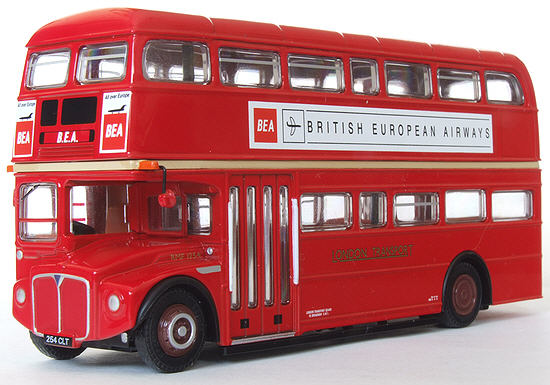
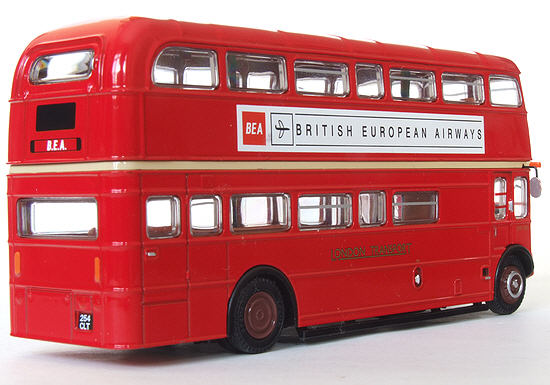
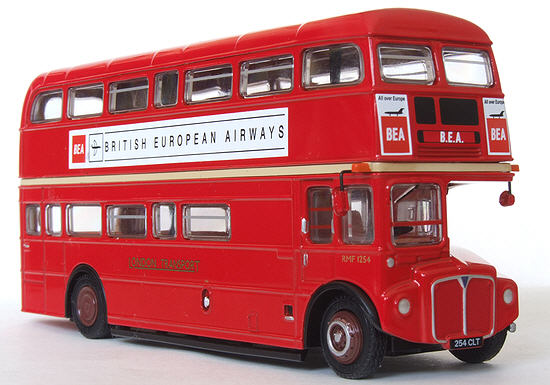
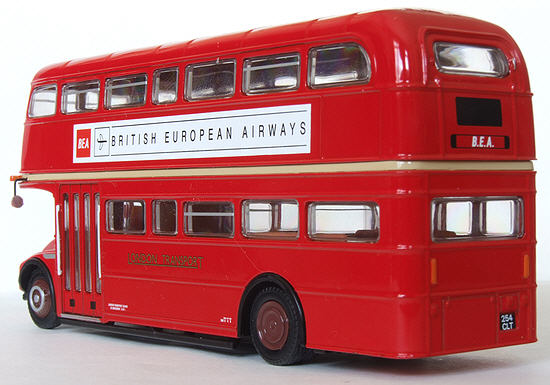
32101 London Transport RMF1254 while on trial with B.E.A.
|
|
Despite a couple of minor points EFE have once again managed to capture the spirit of this unique prototype bus, most of the problems mentioned above are finishing issues and on the whole the casting has been well executed. It remains to be seen whether any changes are possible to front panels as in the present configuration the casting can't be used to produce a wholly accurate reproduction of one of Northern's own batch of Routemasters.
|
| Some possible future models
London Transport (on loan to Halifax)
Northern General (traditional livery with underlined fleetnames)
Northern General (traditional livery with plainer fleetnames)
Northern General red & cream livery
Northern NBC red
Northern NBC yellow
Stagecoach Magicbus
Stevensons of Uttoxeter
Big Bus Company
London Sightseeing Tour (on hire to London Transport)
London Sightseeing Tour (London Coaches)
Time Travel
|
|
| Model Review Index |
|













